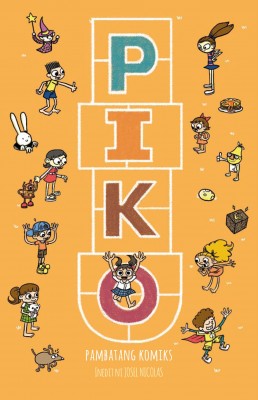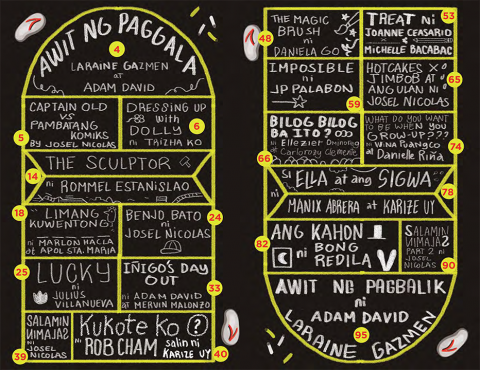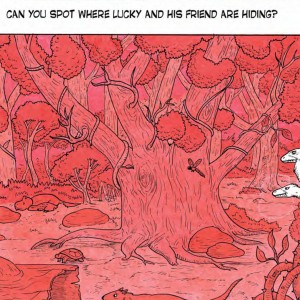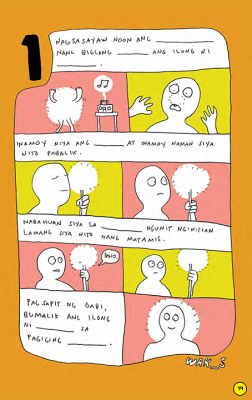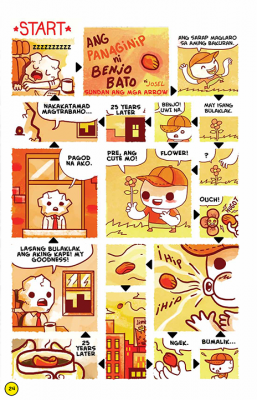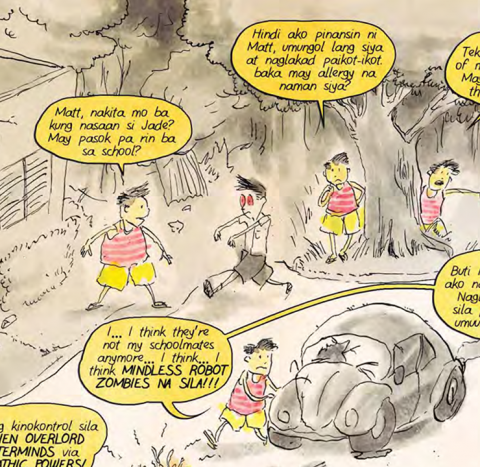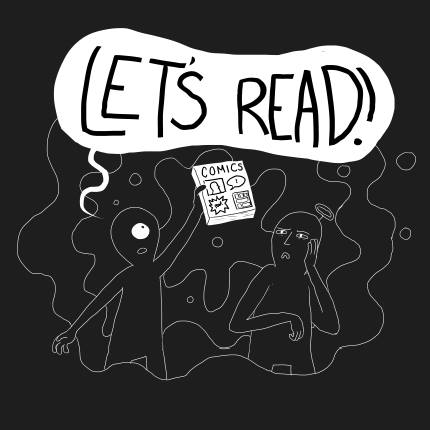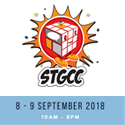FLIPGEEKS: How long was this project from concept to now which is almost going to the printing presses?JOSEL NICOLAS: It took about 1 month of conceptualization,
Adam (David) came up with the name and I came up with the idea of it being interactive after pitching to have a madlib styled comic written by
Marlon Hacla and drawn by
Apol Sta. Maria. It took around 7 months all in all. It was around 2 months before we had everything tied down from contributors and stories submitted. These works were work shopped and talked about a lot, because I wanted
Piko to have a very unified vision. There being a lot of anthos that just are basically collections of disparate stories, and initially I pitched an idea that it could be fun to have a shared universe. But that didn’t quite work out.
What komiks could you recommend that kids can/should read?
I wont presume to have read a lot of kids komiks, truth be told I didn’t have a lot of kid friendly material growing up.
My earliest memory of reading was readers digest and reading about the lochness monster and big foot and aliens. But Tintin is something I wish I had read growing up, as well as any comic similar to
Kuting Magiting. And maybe things like
Little Lit, edited by Art Spiegelman, which is something that was suggested to me by Adam as something to look into. Its a bunch of mostly non mainstream creators like Dave Mazuchelli, Dan Clowes, Kaz, Charles Burns, and Kim Deitch making spectacular comics for kids.
Should some komiks creators start thinking about to make more kid-friendly or a more all-ages books?
I think its definitely a way into the market and I personally feel there aren’t enough people making stuff that they would want their own kids to read.
We’re so focused on adult stuff, and I myself am guilty of being so insistent that the comic should grow up, that I forget that the expansion should go both ways. We should have our Watchmens as well as our Super Duper Mans (Mad Magazine). We tend to think that the way to develop komiks is always to be more mature, and often that translates into unrelenting grimness or just always marketing towards or grown up teens, but it should go both ways. If we nurture children’s taste in craft and art at an early age, we set up better readers later on which will allow us to make even more daring work. Working with kids in mind I found a different set of aesthetics and responsibilities doing Doc Brick. It’s really quite liberating to be silly for silliness sake, and to plot an adventure in 4 pages or less. Doc Brick, was for me, an expression of everything that I loved growing up. Science, imagination and other dimensions.
Do you have a goal to present Piko in schools?
When it gets printed I wanna go back to my school in Batangas and do a komiks reading there with all of the creators.
How hard was it managing over 10 plus talents in this anthology book?Hard, but a lot of these guys are super professional and I have a working relationship with. Some were hands off through out the whole process and surprised me come deadline while others like
Trizha Ko were in contact with me. We even helped each other make comics on the same day.
For those who wants to be editors, what are the must-knows to be a good editor?
Making comics in itself is hard. You have to worry about art, and writing, and on top of that you think about layout and book design. Not a lot of people are good in all these fields, and you can focus efforts on art or writing, and it’s understandable to let other aspects slide. That’s where editors can help, they’re your fresh eyes when you hit a wall, or are confused in what you want to do. They can help you articulate what about your work is so special because first and foremost I think an editor is someone who sees potential in talent and sees what the talent wants to achieve and can provide solid clear cut suggestions to bring about the fullness of their work. Comics is a highly niche and specialized craft, so I’d say an editor who wants to work in comics should first of know how hard it is even to make one and be as objective as possible in their edits, seeing as when a page is drawn it’s drawn and there’s very little to do to change it. A good comics editor has to have a system to minimize possible mistakes and oversights, and one way is through pitching and extensive thumbnails. You can skip out on the trial and error of making the comic, by catching mistakes earlier in script or thumb form depending on your work flow. There is no one way to make a comic, an comics editor has to be sure of how his creators working methods are.
Bong Redila didn’t even do pencils, just straight pen to paper! Some people make extensive scripts laying out both verbal and visual ideas. Another thing is to be able to communicate and haggle with creators, understanding that at the end of the day you are suggesting mostly to them, at the same time they are asking you to see if their work can fit a book. Its curatorial work, it’s also pragmatic stuff like coloring and grammar stuff (which I am admittedly terrible at, which in this case thanks to Adam David, Karize Uy and
Carljoe (Javier) for helping me catch problematic sentence structures and typos which I cant find because I myself am a horrible speller.) But at the base of it I think an editor can be a job for someone who is a fan of creators and their work. An objective fan hopefully, but I think you have to factor in that the book you are editing is a book you would like to read.
QBCCC was just this huge con-job where me,
DJ Legaspi and
Mervin Malonzo tricked people into making new work for us to read. Well
Piko isn’t so different, I tricked people who I was a fan of into making stuff I would want my young self to read and be influenced by. Incidentally, another book that I keep coming back to when designing anthos is the Ivan Brunnetti edited 2 volume set of
An Anthology of Graphic Fiction, Cartoons and True Stories published by Yale. It’s this all encompassing anthology with a historical framework that provides the reader most of the classic comics work starting from the 70’s. Its a great collection from everything to Crumb, to Ware. I think it makes for a better experience when you have a set statement in your head of how you want the book as a whole to be read and defined by the reader. Not that that’s always the case, not every anthology can do that, but I certainly think it wouldn’t hurt to have some sort of skeleton for the book you are helping to make.
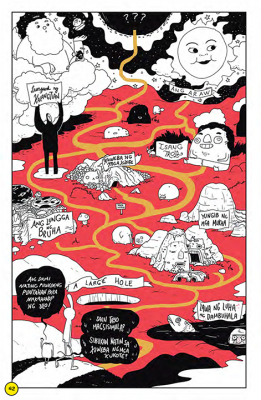
Indie komiks is DIY, most of the time solo ka lang, some times – collaborating with a writer/artist. Do you think editors should be a good addition?Well growing up in the 90’s reading a lot of past anthos and finding a lot of them lacking in firm editorial handling I think its a new aspect of the komiks scene that must be developed. its Komikon 10 or 11 now, we gotta step up and learn to organize and edit and know what kinds of work we actually want to read. I think being in the tiangge, has shown me that there is a whooooooooooooooooooole lot of talent out there, in different stages of development. Not everyone can get to the next level on their own for one reason or another. Not everyone thinks about their work obsessively or is objective about their work. I know for my part, I’ve been edited by friends on windmills and other projects and they’ve helped me conceptualize and solidify aesthetics and storytelling methods. part of me thinks is being edited a compromise to your vision? It depends, there are some works that need no editing, and some that do. It’s really up to the creator if they want help in it, and a lot of the time editors really are just people to bounce ideas off on, or to test things out on. An artist worth his salt will have a million ways to get a job done, editors can help lower that number. A lot of my work has been passed through Adam David,
Noel Pascual, Mimi Johnson,
AJ Bernardo, and I like to think that they’ve suggested some of the clearest bits of insight about work. Personally speaking, when a work is done, I have a very hard time thinking if its any good, so I show it to people and have them decide. Or I kind of have arguments with them, trying to explain what I was doing and then them pointing out “oh, Josel, no one will understand that” and me conceding that I am dumb. . . What I am saying is, I don’t think I would have gotten as far as I’ve gotten (trust me if I didn’t meet Adam David I’d still be making comics about John Wilkes Boothe, Jimi Hendrix and Kurt Cobain) without having had insightful people “Editors” to show my work to. They’re just people who you can choose to listen to, and whose opinion matters a lot, and at the end of the day you trust them to want the best for your work.
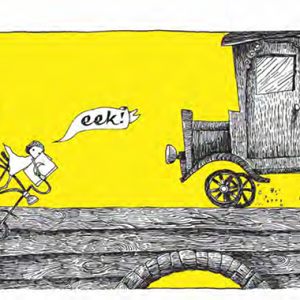
How did your cast of talents pitch their ideas to you? Were they broad and rough? In this project did you assigned writers and artist to collaborate? If you will work with them who and who would you appoint to team-up? what are their strengths? in what genre?
Well there were 3 types of collaborations that happened here.
1.) Solid writer-artist, like
Julius Villanueva, Trizha Ko, Dani Go,
Rob Cham (with translations by Karize Uy) and Bong Redilla.
2.) Writer paired up with artist like, Karize Uy and
Manix (Abrera), and Wina Puangco and Danielle Rina, who I paired up with each other without them having worked together before.
3.) Previous writer-artist collaborators, like Marlon Hacla and
Apol Sta. Maria who have had working relationships before. Adam David and Mervin Malonzo as well.
I made sure that there were no overlapping genres, like there only had to be one story about robots. But that said its really fun to realize that there are recurring images all through out the book. Like the idea of sleeping and waking up shows up a great deal in the stories. I like that a lot and it was unintentional. There is also a lot of stories about girls. I’m really happy to have that, because that’s one of the things we never notice but should, is that females are underrepresented in a lot of komiks even though there are like a lot of female creators out there doing extremely great work.
Who should the people look out for this year? Have they tried sharing their upcoming release projects to you?Madaming magaling. I can’t even pretend to know who currently is doing amazing stuff. People should search them out because its super worth it. I think
Rawrr (Patrick Enriquez) could come into this own this year, I’ve been seeing pages he is doing and I think he might be releasing something that I will love. But that’s a ways off, but man, those pages were really well done. Patrick is one of the hardest working komikeros out there and its only a matter of time before he hits gold. CHED DE GALA, I love her work, and there is a lot of it out there. I like people who consistently put out stuff, and I love seeing them grow and mature. Ellezier Ominoreg’s Boobies is my favorite comic of my
BLTX haul people should buy that. It made me weep. Mich Cervantes did a HIGH-larious comics reading of her work. Tilde Acuna whose work I adore and is in fact a great genius of the comic scene keeps making stuff that is absolutely crazy and political. I miss DJ Legaspi’s work a great deal. He hasn’t released the third part of
??? to the public but I think its gonna be special. I read it, its about his wife and children.
Where the heck is DJ?!
DJ is caught up in life. and being a father.
You’ve had experience with QBCCC. How is Piko different from that? Which is harder to work with, fresh young talents or well-experienced top caliber ones?
One difference is the timelines for those who are still students tend to stretch out because of school work. Another is just being way more mindful of the audience. We have to really think hard about what message we want to present to kids. And I’m saying this having thought about it a lot, it’s because as honest as kids are and as tough critics they can be, they are also completely open. I say this, having grown up watching scooby doo and thinking that it’s the greatest show on earth, having found out it was actually pretty horrible half of the time (I remember Adam David saying he hated that dumb show, and me feeling shame for loving that dumb show, and loving one of the worst parts of said dumb show, which is Scrappy Doo). Children will like almost anything if you introduce it to them. Think about that for a second, the water mark for their enjoyment is literally based on how old they are at the time. So let’s say you are 7 years old, and all you’ve been shown is Scooby Doo reruns, and you end up just having that much of a limited world view based on that show that was intended for kids, but was in no way trying to nourish said kids. He’d be an okay human being, but he might not have as vivid of an imagination(of course this is conjecture, but I hope the point is made). If he were to create a show, he probably would create something similar to Scooby Doo, which honestly would be kind of dumb and boring but understandable in his case because he just doesn’t have enough of a cartoon library to create something new from. Now imagine a kid having grown up on stuff like Robotech, Dexter’s Laboratory, (The Adventures of) Pete and Pete, Felix The Cat, Rocko’s Modern Life. Imagine what kind of cartoon he could make? It’s not hard to see that we end up making stuff inspired from our childhood. If you think about Star Wars, Indiana Jones, Happy Days, The Guardians of the Galaxy, Pacific Rim, they’re all harkening back to something that was clearly personal to these creators. Guardians is basically an 80’s movie. Indiana Jones harkens back to Tintin and adventure serials. Happy Days is a throwback. Going back to Watchmen, the idea of how to do it was based on a Mad Magazine strip by Harvey Kurtzman and Wally Wood named SUPER DUPER MAN. Now if kids are just predisposed to loving any crap you show them, then why not show them something that they could actually take well into their adulthood and be better for it? That was the frame by which we all wanted to work and how we hoped to create PIKO. As far as the which is harder to work with fresh talent or top caliber ones, I honestly don’t see much of a difference. Some were faster than others, mostly because a lot of the contributors were still in college. I think a lot of us are peers anyhow, regardless of how long we’ve been working.
What parts of this book did you like?Hmmm… I like the whole book [laughs], I like that Julius got to talk about evolution and that Trizha slipped in Chinese-Filipino stuff. I like that
JP (Palabon) got to tell his kids story that would inspire kids to aspire to shoot for the stars in terms of career choices. Manix and Karize’s piece is especially poignant to me because it discusses Yolanda and dealing with storms and tragedies.
Did this book make you be a better person in socializing with kids?
Well getting to be an uncle made me want to be that. A lot of this book is for my nephew – Josh Salwen. And some of it actually is just general fears about growing up, as you can see most of my stories in the book deal with jobs and fathers. Not that I am a father, or not even that I still have a job, but you know. It’s a huge responsibility. Josh’s father is a geek and he’s gonna have the geekiest childhood ever between me and his dad. [laughs]
Do you think you’ll make a book based/inspired by him? Or is PIKO it?
Benjo Bato is both me and Josh. [laughs]
Its me wanting to be happy like a kid again and me worrying that Josh could grow up into having a job that is terrible.
But a book about him wouldn’t be so bad. I definitely see myself making more young adult and kid friendly stuff, as weird as this turn has been for me.
In your personal work , do you have any coming out this year?
Well the “Baqbaqan” thing is actually a staggered way to do Windmills 6, I’m taking it absolutely seriously even if its supposed to be a fun side project.
I’m about 95% done with secrets with Fidelis Tan. I don’t know if I’ll be releasing it within this year as it is a sensitive topic and I want to make it come out in perfect form so that theres not much controversy. I got a buncha zines backlogged, some of which are terrible descents into depression and stupidity…
So I don’t think I’ll be releasing anything this year.
In what areas were you had trouble in editing?
Timelines and deadlines. And scheduling. Its mostly been a breeze on the part of most of the contributors.
Who was the fastest to pass his/her work?
Bong Redila was the fastest the sunod si Trizha Ko.
Will there be a volume two? What new faces would you like to work with?
I don’t know if there will ever be a volume 2. I would hope there will. I’m gonna search out people sa Komiket.
Most children know about superheroes in comics. We’re lucky with our generation to have Sesame street and Cartoon Cartoon. if you could choose one piece of art or story and present it to a child to make his/her decision to purchase/read Piko, whose would it be?
Maybe Dexter’s Laboratory, or… a Doctor Suess cartoon. The old Chuck Jones ones.
What should children feel/think while reading Piko?
I would want them to feel like they could make their own comics, and understand that the stuff they watch, isn’t made by companies, but made by people like them.
I think even though Piko is an anthology, it also acts as a cohesive book that might not be connected plot wise but is connected thematically and as a whole makes one complete statement, which is the empowerment of imagination through active participation. Through play. Which is one of the grounding aspects Piko tries to get out there, creators playing. The audience as co-creator and contributor. There are a lot of parts of the book where you are asked to fill in the blanks, draw a characters face, choose your own path in the adventure, and that for me I feel is some of the most fulfilling aspects of Piko. That its fun. That it’s some of the most inventive creators playing around with the comics form, tearing it apart, pulling it back together, calling attention to it’s own self as a comic and a product that was made by people. Its experimenting with comics, teaching kids how to read komiks and the possibilities of comics and art. Down to book design I wanted it to be opened and closed by the idea of play, and I’m immensely happy and grateful to have the phenomenal extra special and lovely Laraine Gazmen be the title page of the book, and provide the intro and outro comix with Adam David providing the poems to open and close the book. I hope that reading the book cover to cover gives the reader a feeling of it being one long day of play in the lives of the children featured in the title painting. I cant stress enough how key the image of children playing outside is to this book, because at the end of the day I’d love for kids to go outside act out the stories they’ve got in their own heads. One very special aspect of the book to me is the contributors page which is laid out as a comic, that will hopefully establish to kids how the things they enjoy are things that they can create themselves.
Did you decide on what activities to feature in each story, (eg, fill in the blanks, locate them)?
Mix and match. Yeah. Some I suggested some they thought off on their own. Rob’s thought of the really neat head parts after I suggested I want him to do a fantasy story, with maps and stuff. It was really a mix.
Would you call Piko as an indie? Do you still call yourself “indie”? Does it matter?
It doesn’t matter. It’s not indie in the sense that it has a publisher and there is money put into it, but the talent is mostly indie. And the distinction between mainstream and indie has always annoyed me, being that the real difference is a company is making money off of someones work and the mainstream has a bigger “audience”. But the audience might be bigger and the distribution larger, we still all mostly grew up out of the indie tiangge. The talent incubator, if you will, is Komikon and still one of the primary selling places.
After Komiket, when will it be released on local brick & mortar stores?
It’ll be released some time after April, I’m not sure of the particulars
Now that PIKO is now soon to be heading to the presses, how will you celebrate this moment?
I’ll only celebrate once I have the actual book in my hands, and maybe I’ll show my little nephew so he can eat the pages (hes not even 2 yet)
Any last words that you wanna share about Piko?
I hope its the kind of book that you don’t forget when you grow up. and that you pick up as an adult and see that it did have an effect on you. And as much as I rattled on about being the editor of this book, I really had a lot of great help from people like Adam David (who stopped me from naming it Hiraya and suggested Piko and it would come to define the politics and aesthetic of the whole book, and edited some tagalog bits I was unsure of! Salamat!), Carljoe Javier (keeping the book on track and helping edit various bits, and giving me this opportunity to even edit a book! thanks man!), Apol Sta. Maria, Karize Uy (who helped me in sooo many different ways and kept me from sinking, and translate a lot of Rob Cham’s comic in the book, which is amazing, stepped up to work with Manix who is awesome for being able to contribute on such short notice), Marlon Hacla (helped me with poetry stuff!), Tilde Acuna, DJ Legaspi (he is my heart and was responsible for helping me finish this book by keeping spirits up and saying to not quit), Laraine Gazmen (whose wonderful painting opens and ends the book so wonderfully that I cant imagine anybody else in her place) and Dark Chapel (who incidentally was the inspiration for Piko in part, seeing SSM JET, a really good kids comic). Trizha Ko for being the consummate professional and for creating the character which I keep raving about (Lavinia). I’m probably getting a tattoo of that dumb dog. For Mica Agregado for providing the inside cover art on such short notice. And everyone at Anino who trusted me enough to do such a weird book with all of the people whose work I am an absolute fan of. Without their insight and help, I don’t know, I probably would have just given up.

